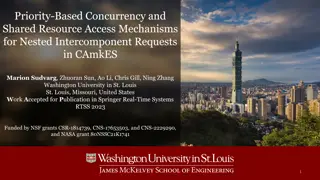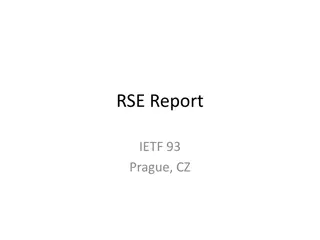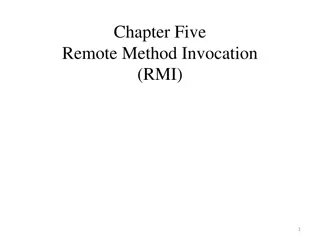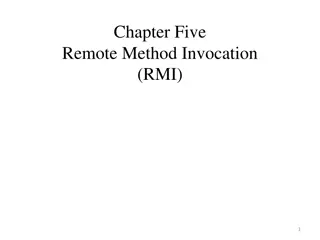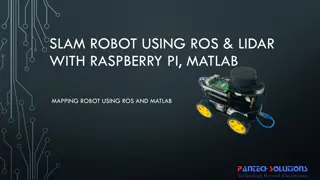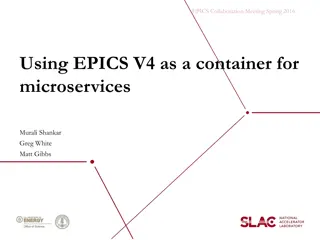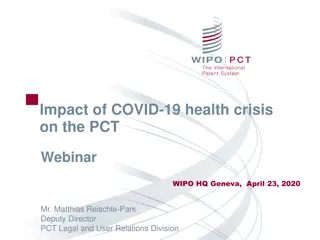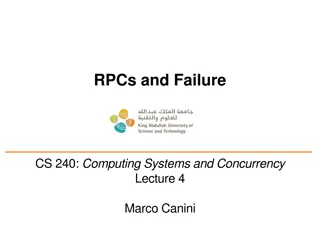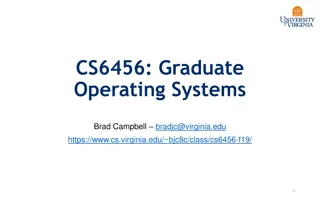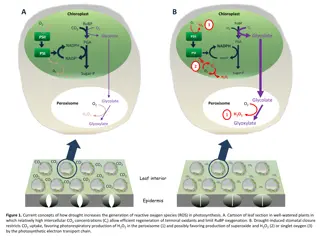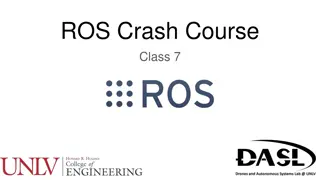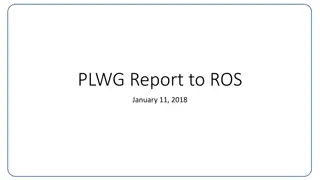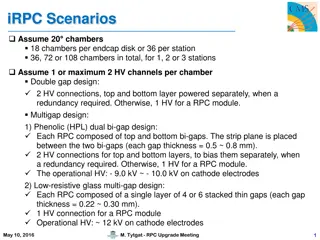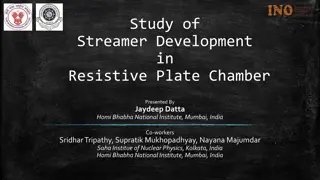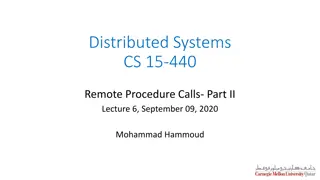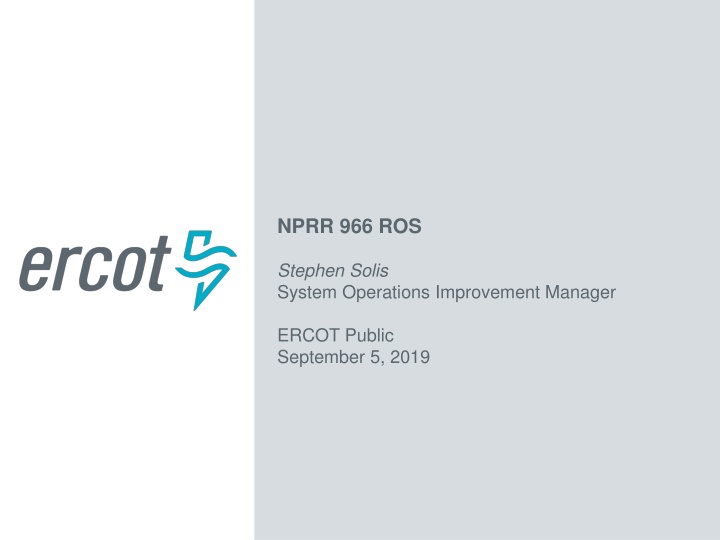
Optimizing Reactive Power Coordination in the ERCOT Interconnection
The integration of renewable generation in the ERCOT interconnection has led to the need for a new tool to coordinate voltage and reactive control between Transmission Operators (TOs) while maintaining reliability, minimizing costs, and improving transfer capability. ERCOT is developing the Reactive Power Coordination (RPC) tool to optimize reactive power controls across multi-hour intervals under various conditions, aiding in real-time operations planning and offline studies.
Download Presentation

Please find below an Image/Link to download the presentation.
The content on the website is provided AS IS for your information and personal use only. It may not be sold, licensed, or shared on other websites without obtaining consent from the author. If you encounter any issues during the download, it is possible that the publisher has removed the file from their server.
You are allowed to download the files provided on this website for personal or commercial use, subject to the condition that they are used lawfully. All files are the property of their respective owners.
The content on the website is provided AS IS for your information and personal use only. It may not be sold, licensed, or shared on other websites without obtaining consent from the author.
E N D
Presentation Transcript
NPRR 966 ROS Stephen Solis System Operations Improvement Manager ERCOT Public September 5, 2019
Problem Statement The integration of renewable generation within the ERCOT interconnection has introduced several new Transmission Operators and fundamentally altered the generation dispatch pattern in the region. A new tool is needed to address multiple interrelated objectives of coordination of voltage and reactive control between TOs, maintaining reliability by preventing and or correcting System Operating Limit (SOL) exceedances, minimizing cost of maintenance resulting from increased switching, and maintaining or improving transfer capability both in real time and in operations planning timeframe. 2 PUBLIC
Reactive Power Coordination Tool ERCOT is actively working on a project to develop a multi hour look ahead tool to improve reactive power coordination within the ERCOT region. This tool will be called the Reactive Power Coordination (RPC) tool. The RPC tool will optimize reactive power controls (shunt devices, Generator Voltage Set Points, Static Var Compensators (SVCs), etc.) across a multi-hour interval to resolve reactive power and voltage-related constraints (voltage limits, temporal constraints*, reactive reserves, etc.) under both normal and contingency conditions. *Temporal constraints are time based constraints (e.g. How often you can switch each reactive device in a certain time period). 3 PUBLIC
Reactive Power Coordination Tool The RPC tool will be used in several studies looking ahead. Hourly study that optimizes across the next 12 hours. Daily study that optimizes the same window as Daily Reliability Unit Commitment (DRUC) . Incorporated into operations look ahead studies Offline planning study mode that will work with bus branch cases (e.g. SSWG). 4 PUBLIC
RPC Output Mock-up Screenshot Total # of Control Actions 2 4 0 0 2 4 0 1 1 2 0 3 2 2 0 2 2 Transmission Operator Device Name Run Time Device Type STATION KV HE 01 HE 02 HE 03 HE 04 HE 05 HE 06 HE 07 HE 08 HE 09 HE 10 HE 11 HE 12 1/1/2018 0:02 ERCOT 1/1/2018 0:02 ERCOT 1/1/2018 0:02 ERCOT 1/1/2018 0:02 ERCOT 1/1/2018 0:02 ERCOT 1/1/2018 0:02 ERCOT 1/1/2018 0:02 ONCOR 1/1/2018 0:02 ONCOR 1/1/2018 0:02 ONCOR 1/1/2018 0:02 ONCOR 1/1/2018 0:02 ONCOR 1/1/2018 0:02 ONCOR 1/1/2018 0:02 CENTERPOINT GENERATOR BEACHSAND U1 1/1/2018 0:02 CENTERPOINT GENERATOR BEACHSAND U2 1/1/2018 0:02 CENTERPOINT GENERATOR BEACHSAND U3 1/1/2018 0:02 CENTERPOINT CAPACITOR NASA 1/1/2018 0:02 CENTERPOINT CAPACITOR NASA REACTOR CAPACITOR MET CAPACITOR MET CAPACITOR MET SVC GENERATOR AUSTIN REACTOR REACTOR CAPACITOR SIDEHILL CAPACITOR SIDEHILL LTC LTC MET R1 C1 C2 C3 SVC1 UNIT 1 138 RX1 RX2 CX1 CX2 LTC1 LTC2 69 69 69 69 138 ON OFF OFF OUT 141 142 OFF ON ON OFF 5 5 70 70 OUT OFF OFF ON ON OFF OUT 141 141 OFF ON ON OFF 5 5 70 70 OUT OFF OFF ON ON OFF OUT 141 141 OFF OFF ON OFF 5 5 70 70 OUT OFF OFF OFF ON OFF OUT 141 142 OFF OFF ON OFF 5 5 70 70 OUT OFF OFF OFF OFF OFF OUT 141 142 OFF OFF ON ON 5 5 72 72 OUT OFF OFF OFF ON OFF OUT 141 142 OFF OFF ON ON 5 6 72 72 OUT ON OFF OFF ON OFF OUT 142 143 OFF OFF ON ON 5 7 72 72 OUT ON OFF OFF ON OFF OUT 141 143 OFF OFF ON OFF 5 7 72 72 OUT ON ON OFF OFF OFF OUT 141 143 OFF OFF OFF OFF 5 5 72 72 OUT ON ON ON OFF OFF OUT 141 142 OFF OFF OFF OFF 5 5 70 70 OUT OFF OFF ON OFF OFF OUT 141 142 OFF OFF OFF OFF 5 5 70 70 OUT OFF OFF ON OFF OFF OUT 141 142 OFF OFF OFF OFF 5 5 70 70 OUT OFF OFF MET HILLSIDE SIDEHILL 138 138 345 345 69 69 69 69 69 69 69 LEFTDRIVE LEFTDRIVE CAP1 CAP2 5 PUBLIC
Reactive Power Coordination Tool benefits Fewer real time voltage limit exceedances Help to ensure that sufficient reactive reserves are maintained Fewer real time Constraint Management Plans (CMPs) and more identified in advance of real time. Improved reactive flows (e.g. lower MVAR flows in some areas, fewer areas with circulating MVAR flows, etc.) Enhanced coordination between TOs Allows for more realistic and reliable future look ahead studies 6 PUBLIC
Time Frame ERCOT would like to have NPRR 966 make the December 2019 Board meeting to support finalization of planning activities in 2019. Preliminary scheduling estimates would make production capability sometime mid-2021. This schedule will be finalized by end of 2019. ERCOT expects to test or pilot results for 3 to 6 months to tune, stabilize and build confidence in the reactive dispatch prior to un gray boxing NPRR 966 language. 7 PUBLIC
Coordination between ERCOT and TOs Project Implementation Coordinate on necessary constraints for the RPC tool (e.g. temporal constraints) Coordinate on necessary cost /weighting factors for control selection in the RPC Tool (i.e. prioritizing which reactive devices should be utilized in what sequence) Coordinate on the RPC tool reactive dispatch output file design Rule Changes Coordinate and implement NPRR 966 Gray boxed until project goes live Testing Manual review of RPC tool reactive dispatch for issues Pilots and tests of implementing actual RPC tool reactive dispatch 8 PUBLIC
Impact on Generators Voltage Set Point changes Some generators may see an increase and some generator may see a decrease in the number of Voltage Set Point changes which depends on the topology and reactive controls in an area. Generator Voltage Set Point changes will be given a higher control cost in the optimization engine so that Transmission reactive devices are utilized first up to a combined cost that exceeds the cost of the Voltage Set Point change. Generators will still receive Voltage Set Point changes the same way as today from their ERCOT Transmission Operator even if the change was part of the optimized reactive dispatch. 9 PUBLIC
NPRR 966 Outage Coordination Sections 3.1.4.3 and 3.1.4.4 clarifies expectations for entering Outages for reactors, capacitors, reactive controlled sources for Resource Entities and TSPs so that the Reactive Power Coordination tool can have accurate awareness of the availability of the reactors, capacitors, and reactive controlled sources; 10 PUBLIC
NPRR 966 Modeling Sections 3.10.7.1.4 and Section 3.10.7.1.5 specify the need to add temporal constraints to the Network Operations Model for transformers and reactive devices so that the Reactive Power Coordination tool can have accurate awareness of any temporal constraints of the reactors, capacitors, or other reactive controlled sources (e.g. how many times a capacitor can be switched in or out in a 12 hour period); and This will be similar to the information received as part of a survey in 2017. 11 PUBLIC
NPRR 966 Voltage Support Service Paragraph (7) added to Section 6.5.7.7 for ERCOT to provide the hourly optimized reactive power dispatch via a TSP-specific Messaging System and also to post the schedule on the MIS Secure Area accessible by the TSPs. This Messaging System will operate very similarly to the one utilized with Qualified Scheduling Entities (QSEs) but will be for TSPs. This will require the TSPs to implement an application programming interface (API) on the TSP side to interface with the Messaging System. The TSPs will be responsible for providing this Dispatch schedule to their operators. The TSPs will also be required to send an acknowledgement of receipt each hour. The TSPs would be required to implement and or instruct others to implement the Dispatch schedule unless they determine they should not due to reliability reasons (e.g. a Forced Outage occurs that modifies the necessary reactive Dispatch or the inability to implement the Dispatch, severe weather, etc.). ERCOT will be required to notify the TSPs when the Reactive Power Coordination tool is unavailable and when it becomes available again. 12 PUBLIC


